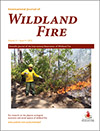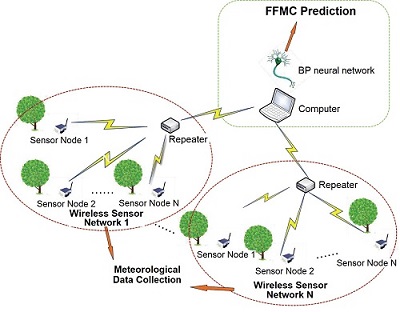
International Journal of Wildland Fire
Volume 31 Number 4 2022
WF21075Residual forest structure influences behaviour of Pacific marten (Martes caurina) on post-fire landscapes
Wildfire and post-fire salvage logging alter forest structure, but consequences for wildlife are uncertain. We examined forest-specialist Pacific marten (Martes caurina) on three recently-burned landscapes in Washington and British Columbia. Marten selected lightly-burned sites with overhead cover and high structural complexity, but avoided severely-burned and salvage-logged sites lacking these features.
WF21075 Abstract | WF21075 Full Text | WF21075PDF (9 MB) | WF21075Supplementary Material (1.2 MB) Open Access Article
WF21112The role of decomposer communities in managing surface fuels: a neglected ecosystem service
Ground fuels (leaf litter and logs) are important in forest fires, but how decomposer organisms (invertebrates, fungi and bacteria) affect fuel breakdown is rarely considered. We review the evidence for the importance of decomposer organisms and its regulation by global change, highlighting knowledge gaps and the way forward.
WF21112 Abstract | WF21112 Full Text | WF21112PDF (2.4 MB) | WF21112Supplementary Material (129 KB) Open Access Article

In this paper, wireless sensor network and back-propagation neural network were used to estimate the dead fine fuel moisture content (FFMC) of forest surface. The method can be well applied to forest surface dead FFMC estimation and early fire danger assessment, having practical significance for forest fire protection.
We propose a new method for short-term fire danger mapping using deep learning based on simulated fire sizes. High-resolution maps can be obtained in a few hours using actual weather forecasts and terrain data. Application to 13 fire cases shows relevant predictions of potential for fire spread.
WF21053Variability in pyrogenic carbon properties generated by different burning temperatures and peatland plant litters: implication for identifying fire intensity and fuel types
Pyrogenic carbon (PyC), generated by fire, acts as a stable carbon deposit and is stored in the peatland soil carbon pool. PyC chemical compositions and thermal stability are significantly affected by burning temperature and fuel sources, and can be used to identify PyC sources and fire intensity.
WF21053 Abstract | WF21053 Full Text | WF21053PDF (5.2 MB) | WF21053Supplementary Material (351 KB) Open Access Article
WF21141Comparison of fire-produced gases from wind tunnel and small field experimental burns
 , Wei Min Hao
, Wei Min Hao  , Stephen Baker, Marko Princevac
, Stephen Baker, Marko Princevac  , Amir-Hessam Aminfar
, Amir-Hessam Aminfar  , Javier Palarea-Albaladejo
, Javier Palarea-Albaladejo  , Roger D. Ottmar
, Roger D. Ottmar  , Andrew T. Hudak
, Andrew T. Hudak  , Joseph Restaino
, Joseph Restaino  and Joseph J. O’Brien
and Joseph J. O’Brien
Pyrolysis measurements from simplified fuel beds in a wind tunnel were compared with pyrolysis measurements collected during prescribed burns in longleaf pine. Compositional data techniques were applied to predict gas composition of pyrolysis or flaming combustion samples. Relative dominance of some gases differed between wind tunnel and field measurements.
There is a growing interest in connecting fire science and management through processes like co-production of fire science, which can increase the relevance and utility of research products by integrating diverse knowledge and goals. Research organisations can enable and incentivise co-production through modifications to performance evaluations, funding structures and career ladders.
WF21079 Abstract | WF21079 Full Text | WF21079PDF (855 KB) Open Access Article
WF21090Predicting daily initial attack aircraft targets in British Columbia
Statistical learning methods were used to develop predictive models of the likely number and location of daily airtanker and helicopter initial attack targets in British Columbia, Canada, that can inform the day-basing or prepositioning of aircraft to reduce response times.
WF21090 Abstract | WF21090 Full Text | WF21090PDF (10.3 MB) | WF21090Corrigendum (10.3 MB) Open Access Article
WF21090_COCorrigendum to: Predicting daily initial attack aircraft targets in British Columbia
WF21090_COCorrigendum (10.3 MB) Open Access Article



